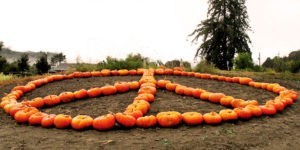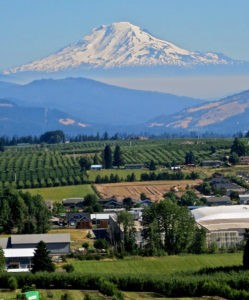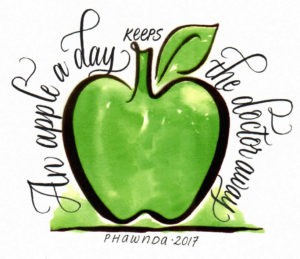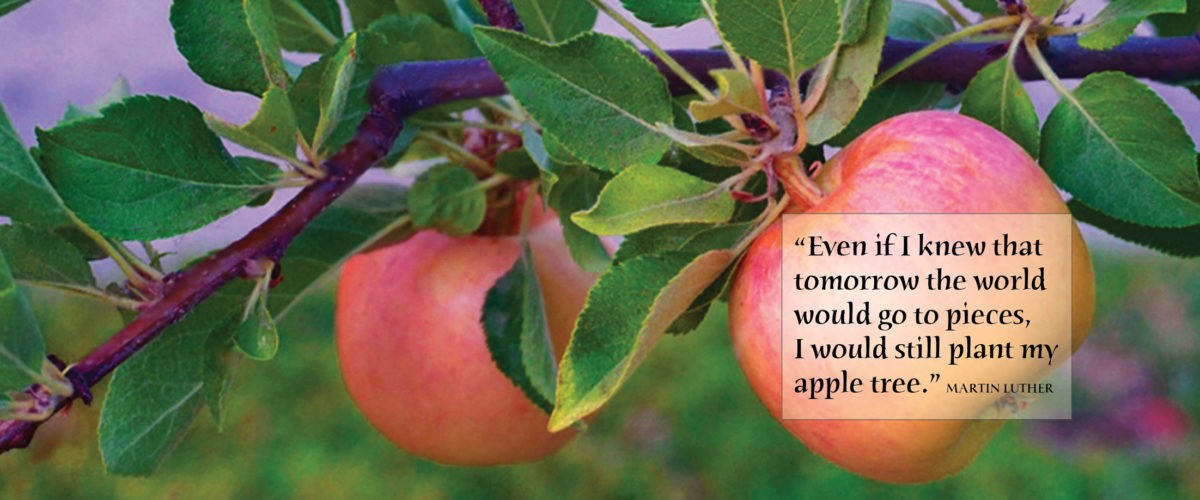Hello, fall — season of planting trees, learning, road trips and comfort cooking. Coming to a community near you, it paints the trees in colorful splendor and invites us all to enjoy the earth’s bounty of fruits and vegetables.

Pumpkin peace display in Carmel, Calif.
Traveling anywhere to see these sights is food for the soul. In Carmel Valley, Calif., we enjoyed this artistic composition. At Mount Hood, Ore., the view promised good things to come.

Mount Hood
In the family of fruits, apples rank first in U.S. consumption, about 26 pounds per year, per person. Red Delicious is the most popular of 2,500 varieties grown. We’re lucky in Northern California to live near orchards, where folks make the trek to purchase a-peel-ing, freshly picked apples, baked treats and refreshing cider (which, by the way, takes 35 apples to produce a gallon). Check local areas for your own “Apple Hill.” Chances are there are some close by to “taste and see that the LORD is good.” Or, travel by armchair.
Apple tree as a statement of faith
It’s believed that apples have been around at least 750,000 years and they were a favorite of Greeks and Romans. Early American settlers brought seeds to plant in New England. Later, “Johnny Appleseed” (John Chapman) took them to nurseries and orchards in the Midwest. The popularity of apples continued and in recent years, growers in 32 states raise them commercially, exporting one apple for every three apples sold at home.
My husband and I have one apple tree, and it’s a statement of faith. Several years ago, I marched peacefully to protest the controversial daily headlines (and I could still be marching). I tried to maintain a good attitude about life and remembered the theologian Martin Luther’s words: “Even if I knew that tomorrow the world would go to pieces, I would still plant my apple tree.”
“My husband and I have one apple tree, and it’s a statement of faith.”
So we planted a small but mighty dwarf Gala apple tree in our front yard. As you may know, it takes a few years before the trees actually produce fruit. I thought of it as an investment in future pies at Thanksgiving, caramel-dipped apple slices, Waldorf salad and healthy snacks, so it was worth it. Our tree is a visual for Luther’s quote, an encouragement to do the right thing even if it may not make the headlines.
An apple a day?
What about the proverb, “An apple a day keeps the doctor away”? The Mayo Clinic says “apples (the original health food) are a good source of soluble fiber, which can lower blood cholesterol and glucose levels. Fresh apples are also a good source of vitamin C — an antioxidant that protects your body’s cells from damage. Vitamin C also helps form the connective tissue collagen, keeps your capillaries and other blood vessels healthy, and aids in the absorption of iron.”
 In mythology, apples are used as an image of love, beauty and wisdom. But life’s moral lessons in fairytales and storytelling often pick apples as a mystical symbol or forbidden fruit. Read more about famous apples and books on Australian blogger Paula Vince’s site.
In mythology, apples are used as an image of love, beauty and wisdom. But life’s moral lessons in fairytales and storytelling often pick apples as a mystical symbol or forbidden fruit. Read more about famous apples and books on Australian blogger Paula Vince’s site.
Apples were once thought to be in the Garden of Eden, but it seems that idea originated in paintings rather than from the Bible. The Italian Renaissance masters Titan and Rubens both painted “The Fall of Man” with Adam and Eve beside an apple tree. However, when renowned Michelangelo painted yet another version of “The Fall of Man” on the Sistine Chapel ceiling in Rome, he (like the German Renaissance artist Durer) used fig leaves, a more likely choice.
George Washington and apples
Parents might be familiar with a childhood story that tells of young George Washington’s father, taking him into an apple orchard one autumn day. It goes something like this: “Now, George,” said his father, “look at our rich harvest of fruit! Do you remember when your cousin brought you a large apple last spring and how you refused to divide it with your brothers? I told you then that if you would be generous, God would give you plenty of apples this autumn.”
George hung his head as he remembered being selfish. His eyes filled with tears, and he promised his father he’d never be selfish again.”
Perhaps (or not), he later axed at a cherry tree, which was created as another lesson — to tell the truth.
“Thankfully, when the first president was at Mount Vernon, there really was an apple orchard and Washington’s hobby was to prune some of the 215 trees.”
Thankfully, when the first president was at Mount Vernon, there really was an apple orchard and Washington’s hobby was to prune some of the 215 trees.
New discoveries
Isaac Newton also had an apple experience, one of the most famous anecdotes in the history of science.
“The young Isaac Newton is sitting in his garden when an apple falls on his head and, in a stroke of brilliant insight, he suddenly comes up with his theory of gravity. The story is almost certainly embellished, both by Newton and the generations of storytellers who came after him. But from today anyone with access to the internet can see for themselves the first-hand account of how a falling apple inspired the understanding of gravitational force.”
Fall’s cooler nights often find me near a fireplace, reading or remembering the excitement of returning to the classroom, both as a child and as an instructor to teach calligraphy. Learning is fueled by lifelong curiosity, a trait that scores very high in creative personalities. Which, according to scientific research by George Land, includes just about everyone in early childhood, but decreases significantly in adults.
It’s a blessing to hang onto (or restore) that marvelous ability to wonder why, to ask for answers, to explore truth. It often happens to adults who take the road less traveled and are willing to embrace solitude to see what happens.
Another scientist, Albert Einstein is quoted as saying: “Be a loner. That gives you time to wonder, to search for truth. Have holy curiosity. Make your life worth living.”
For lifelong learners, fall is the perfect time to take a good book and find a quiet spot near an apple tree — but not too close or you may have your own apple story to tell.
Phawnda Moore is a Northern California artist and award-winning author of Lettering from A to Z: 12 Styles & Awesome Projects for a Creative Life. In living a creative life, she shares spiritual insights from traveling, gardening and cooking. Find her on Facebook at Calligraphy & Design by Phawnda and on Instagram at phawnda.moore.


